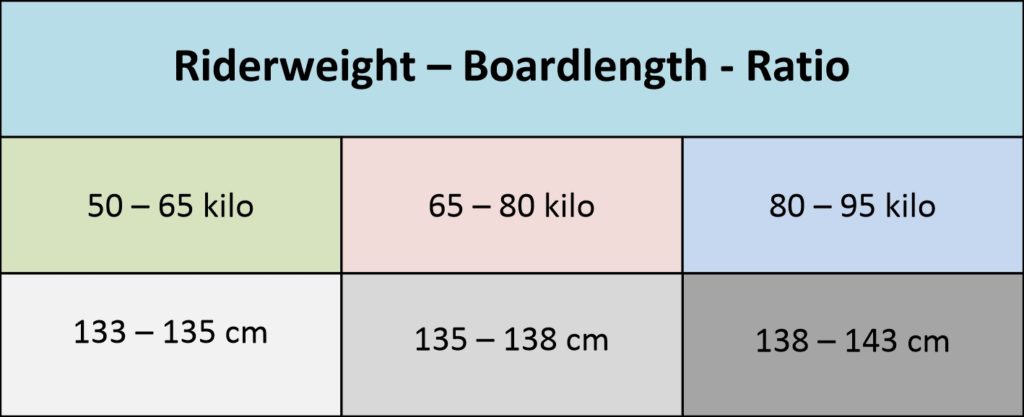The right kiteboard size is mandatory for quick improvement and fun on the water
A lot of kitesurfers have the same question every year: Which is the right size for my kiteboard? How long should it be? How wide should it be? Especially as a beginner, this decision is not that easy. Companies offer kiteboards in sizes from 130cm up to 150cm.
First of all we can say, that kiteboards smaller than 130 cm won´t work really well. The hydrodynamic effects, which lets a kiteboard glide over the water, appear at a size around 130 -135cm. Also the upper side of a kiteboard has a limit. The longer the kiteboard, the flatter it sits on the water surface. This flat angle to the surface results in lower uplift force. The biggest kiteboard size turns out to be at around 150cm. Longer kiteboards, again, have bad hydrodynamic effects.
The width of a kiteboard should be in relation to the length. The factor between length and width should be 3,3 to 1. Other proportions cause disadvantages in hydrodynamics and feelings.
Out of this statements, we get a relation between the rider´s weight and the kiteboard size. This relations is shown in the following chart.
If you use a smaller kiteboard than recommended in the chart, you will feel, that the kiteboard sits deeper in the water. Therefore, it gets a higher angle to the water surface. This will result in a slower ride, lower upwind abilities, less efficiency on the low end and more spray.
If you use a bigger kiteboard than recommended in the chart, you will feel that the kiteboard sits higher on the water surface and get a lower angle. You will feel less in control of the board and feel more impacts of the chop. Also the spray will increase.
Construction
Kiteboards should always be built with a wood core. A wood core represents quality and delivers fun and a long life span. Usually, manufacturers like to show the wood core by integrating it in the design process.
Be aware of foamed cores! New Kiteboards in the shop for less than 300€ will usually be foamed. The foam gets injected between the outside layers. Foamed kiteboards don´t have a lot of pop and deliver a very indirect feeling. We cannot recommend these kiteboards. Not even for beginners or kiteschools. Wood cores get pressed with high pressure and heat, ensuring a long life span. Furthermore, the wood gives a good feedback to the rider. This means more pop and less vibrations.
For beginners and upcoming riders there are specific kiteboards. Basic Freeride kiteboards are suitable. The bottom should have a concave or a concave with channels. Channels are profiles on the running base. Quite simplified we can say: The higher the riders level – the more channels his kiteboard should have.
Kiteboards with a flat running base should be avoided. They get stuck on the water surface very easy, which results in slow and indirect ride. The low end of the kiteboard is not efficient and riding gets exhausting. Similar to a snowboard without wax.
Field of application
Despite the rider´s weight, also the field of application and the style plays a big role in choosing the right kiteboard size. Kiteboards for teaching and beginners are usually a little bit bigger, around 150 cm. Getting on the board is a bit easier, as the bigger surface delivers more stability. As soon as you are able to do the water start it makes sense to choose your kiteboard as shown in the chart.
Good for Beginners is the Woodboard Beam, available in size 135, 138, 143 cm. The Beam is a proved and tested Beginner Kiteboard with a wood core and a single concave on the running base. The Beam has a good low end and low resistant. This delivers a loose feeling while riding. It will beam your progress. As soon as you are able to do you first jumps around 3m, it´s time to switch to an advanced freeride kiteboard.
That´s the point where you should think about the Chame or CRBN. These two kiteboards have the same shape, but get a complete different feeling by using different materials. The CRBN has integrated carbon fibres, while the chame is equipped with a triaxial glass fibre. The CRBN feels much stiffer, delivering a very direct feeling. The chame is a bit softer. Still direct, but more relaxed. One of these kiteboards would be the right choise, if you are looking for an advanced freeride kiteboard. Once your jumps get higher than 10m and you are really enjoying the strong winds, you should get yourself a dedicated big air kiteboard. Unbeatable in this category is the Woodboard Basalt BIG AIR
For riders who want to evolve in the freestyle category, specific freestyle kiteboards and kites are necessary. C-kites and open C-kites are very suitable to unhook. There are special freestyle kiteboards, which are nice to combine with these kites. The freestyle kiteboards have a strong rocker and usually a double concave to take care for soft landings. Plenty of channels in the tips deliver good grip, while taking off unhooked.
The Woodboard Trash fulfils these needs and is a well-tested freestyle kiteboard. Since couple of years there is a trend to ride bigger freestyle kiteboards. That’s why we came up with a bigger size of the Trash. Now available in 143 cm.
Conclusion
Summarized, these are the criteria to choose your kiteboard. In the following order:
- Level of riding
- Weight
- Design
Of course the price also plays a big role, but that’s something you will have to choose by your own. But it should be noted, that a kiteboard can be used several years. While a kite usually gets changed within 3 years. A kiteboard with wood core can be ridden for 5-6 years. Kiteboards with foam core about 1 year.
So, concentrate on kiteboards with wood core and a good value for your money. Kiteboards from Woodboard proofed good quality for a fair price.
Last factor is the design. This might be the biggest factor for some kiters. A manufacturer can choose between a sublimated graphic and a screen printing. Sublimated graphics get printed in 4C, which offer the opportunity to use a lot of different colours. The problem is, that the UV rays from the sun cause optical whitening of the graphic. The colours start to fade away after many hours in the sun. The screen printing graphics usually just use a few colours, but these colours stay much longer on the kiteboard. Screen printing is UV resistant.
So long, keep ripping!

